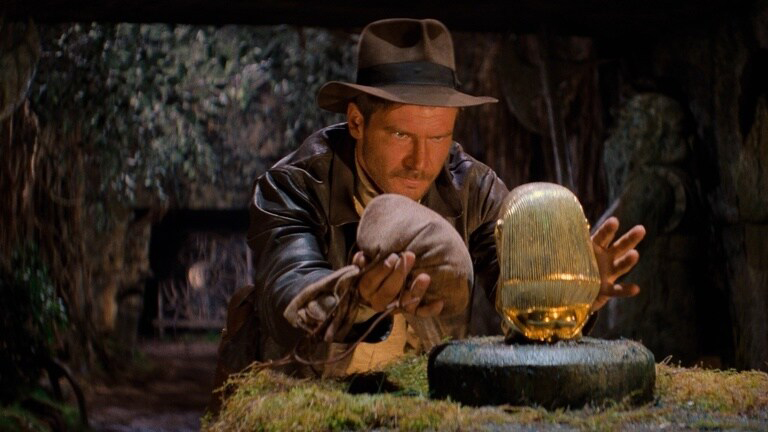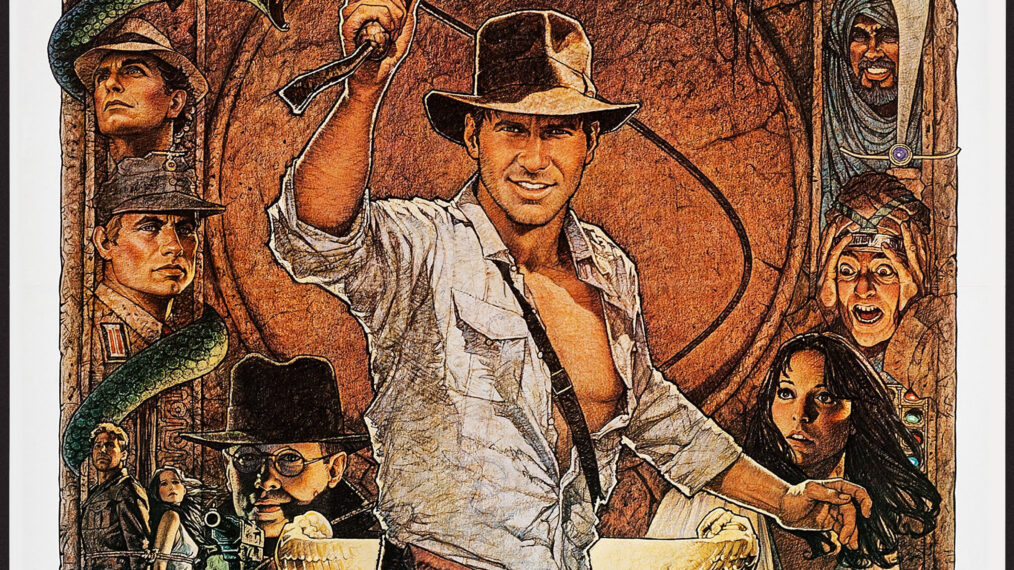The ‘Indiana Jones’ Movies & the Early ’90s ‘Young Indiana Jones’ TV Series Are Coming to Disney+

Ahead of the final Indiana Jones theatrical film — Indiana Jones and the Dial of Destiny, which hits theaters Friday, June 30, 2023 — all four of the previous Indy feature film titles (Raiders of the Lost Ark, Indiana Jones and the Temple of Doom, Indiana Jones and the Last Crusade and Indiana Jones and the Kingdom of the Crystal Skull), as well as the short-lived but fun TV series The Adventures of Young Indiana Jones (formerly known as The Young Indiana Jones Chronicles), will finally be available to stream.
All of these Indiana Jones titles will begin streaming on Disney+ Wednesday, May 31.
Boy, I could have used this convenience as a kid, when I ended up breaking my tape of Raiders of the Lost Ark — my all-time favorite movie — after watching it in full, or fast-forwarding back-and-forth to certain scenes, so often!
It makes sense, of course, that the films will be streaming on Disney+, given that Disney has owned Lucasfilm for a while now.
But it will be interesting to see if the films — which were originally distributed by Paramount Pictures — somehow maintain their memorable introductions, which originally featured the famed Paramount mountain slowly dissolving into a shot of some sort of mountain within the movie as the opening credits began. (One thing I’ve missed with the newer Star Wars movies is something similar, when the old films used to have the classic 20th Century Fox fanfare leading into their opening crawls; but maybe I’m just weird.)
However they may begin, though, the Indiana Jones films are still terrific entertainment, wonderful throwbacks to classic cliffhanger serials, adventure films, comic books and pulp fiction of yesteryear, expertly updated by executive producer George Lucas and director Steven Spielberg.
They, along with star Harrison Ford as the titular globe-trotting, daredevil archaeologist, fire on all cylinders in these movies, especially in Raiders. Of course, they get big assists from composer John Williams, who punctuates each film with not only the famed “Raiders March,” but other terrific music throughout.
I’m glad that these productions have not really been tinkered with too much, as Lucas did with his Star Wars special editions and even Spielberg tried with E.T. There has been a fairly recent retitling of Raiders of the Lost Ark as Indiana Jones and the Raiders of the Lost Ark, which I find off-putting for a few reasons (but the opening credits of the film, at least, still call it Raiders of the Lost Ark; the retitling is more in the poster and other promotional images, from what I’ve seen).
Indiana Jones Titles on Streaming Disney+ Beginning Wednesday, May 31, 2023
Raiders of the Lost Ark (1981)
Raiders of the Lost Ark, the first Indiana Jones movie, is also the best. I’ll be taking no further questions on this. (It is being referred to by Disney+ as Indiana Jones and the Raiders of the Lost Ark, but, man, I just can’t do that; I’ll stick with the old-school title.)
Set in 1936, Raiders finds Jones asked by “top men” in the government to find the lost Ark of the Covenant — reputed to hold the remains of the Ten Commandments — before a team of Nazis, led by Jones’ old adversary René Belloq (Paul Freeman), can get their hands on it and use its power to become unstoppable.
Karen Allen is great as feisty Marion Ravenwood, with she and Ford giving off a Bogart and Hepburn African Queen-ish vibe, as is John Rhys-Davies as Sallah, Indy’s friend and contact in Egypt (Allen would return as Marion in Kingdom of the Crystal Skull, while Rhys-Davies reprised Sallah in Last Crusade and will play him again in Dial of Destiny).
Raiders was nominated for nine Oscars and won four. On Oscar night in 1982, I can’t tell you how upset my kid-self was when the film did not win Oscars for Spielberg’s direction or Williams’ score. But it rightfully took home awards for its technical achievements, and sequences like the famous truck chase — one of the most breathlessly exciting chase scenes ever filmed — offer strong arguments for why stuntwork should be an Oscar category.
Indiana Jones and the Temple of Doom (1984)
This Raiders prequel, which borrows a lot (including some of its racist moments, unfortunately) from the 1939 adventure classic Gunga Din, is set in 1935.
After a terrific opening sequence in a Shanghai nightclub (complete with an entertaining musical number set to Cole Porter‘s “Anything Goes,” which is an accurate slogan for this frenetic movie), Indy, singer Willie Scott (played by Spielberg’s future wife, Kate Capshaw) and his young compatriot Short Round (future Oscar winner Ke Huy Quan making his feature film debut) find themselves mixed up with a deadly cult in India.
Temple of Doom was one of the Spielberg-associated films, along with Gremlins, that were released in the summer of 1984 with PG ratings, but were so intense that they helped spur the introduction of the PG-13 rating in early July ’84, to help further caution parents from inadvertently letting their kids see scenes like a still-beating heart being pulled out of a sacrifice victim by cult leader Mola Ram (Amrish Puri).
(Frankly, Raiders itself was pretty violent and scary considering it, too, only had a PG rating — even beyond the iconic finale in which a bunch of Nazis get their faces melted off. I wonder if Disney+ will have any sort of rating/warning ahead of these, similar to how, at its release, Temple of Doom did mention, right below the PG rating on its poster, that the film “may be too intense for younger viewers.”)
Temple of Doom is intense not only in its content, but also in its pacing; the final half hour or so in particular is an astonishing display of nearly nonstop action, making for a wild ride — sometimes literally, as with the mine cart chase sequence.
Indiana Jones and the Last Crusade (1989)
For this story set mostly in 1938, Spielberg, Lucas, Ford and company toned things down a bit after Temple of Doom, going back to basics — including bringing back the Nazis as the villains — in a Raiders-esque story that again finds Jones in a race to find the Holy Grail.
The addition of Sean Connery as Indy’s dad, Henry Jones Sr., was a stroke of genius, and Connery and Ford play off each other delightfully in a story that at times resembles a comedy (again, perhaps an effort by the filmmakers to lighten the mood after the darkness of Temple of Doom).
Also inspired was the casting of River Phoenix as young Indy in an opening sequence set in 1912. Phoenix captures Ford’s mannerisms in his portrait of the archaeologist as a young man, and the sequence offers an exciting chase aboard a circus train.
That train sequence, and a number of others — including one in which Indy memorably battles practically a platoon of Nazis atop a tank — again demonstrate the terrific stuntwork seen throughout the Indy films.
Indiana Jones and the Kingdom of the Crystal Skull (2008)
After nearly 20 years, Indy was back on the big screen in this story set in 1957. The film still has mixed reactions among fans, a lot of whom don’t regard it as a “real” Indiana Jones movie because of its use of CGI effects; its storyline focused on alien beings and technology versus something out of religion or mythology, as the first three films had; and Shia LaBeouf’s character Mutt Williams, Indy and Marion’s son.
While the CGI moments can be grating at times, this film is not entirely out of place in the Indy universe, even if its overall mystical power is based more in science fiction. With its focus on aliens, and having Russians as the villains (with the always-great Cate Blanchett as their leader, Irina Spalko), this feels like it could be a pulp fiction story out of the ’50s, similar to how the earlier ones had felt like tales from a ’30s work of pulp.
Despite the CGI, there are still some exciting practical effects and stuntwork, as in the terrific opening sequence when Indy escapes Russian thugs at a warehouse in an Area 51-like facility; the Ark of the Covenant even makes a cameo reappearance!
The Adventures of Young Indiana Jones (1992-93)
If you remember this series when it originally aired on ABC as The Young Indiana Jones Chronicles, you’ll recall how ambitious, and often different from the films, it was. Perhaps too ambitious for its own good; its large budget and low ratings led it to being canceled after about a year.
There were also some TV movies based on the series produced between 1994 and 1996, and in 1999, the series was reedited into several movies, with that series of films known as The Adventures of Young Indiana Jones, which is presumably what is airing on Disney+.
The series told the tale of young Indy (played as a boy by Corey Carrier, as a young man by Sean Patrick Flanery and as an elderly man by George Hall) and the adventures he had between about the ages of 9 and 21, during roughly the first two decades of the 20th century, as recalled by himself as an old man in segments that bookended most episodes.
One episode, “Young Indiana Jones and the Mystery of the Blues,” was notably bookended by Harrison Ford in a special appearance as a 50-year-old — and fully bearded! — Jones.
In these adventures, Indy managed to cross paths with nearly every notable historical figure of that time, from Pancho Villa and Mata Hari to Pablo Picasso and Ernest Hemingway.
Most of the episodes featured Flanery’s appearance as Indy, which was good, because they offered the most chance for action, and sometimes romance. The ones with Carrier as the 9-year-old Indy were interesting, but fairly limited storywise, mostly by the character’s age. They probably would be fun viewing for younger viewers to help introduce them to some of the notable figures of history, but in terms of someone looking for pure Indy adventure, perhaps not so much.
But the educational nature of this series was clearly important to Lucas, and was an admirable goal; Lucasfilm produced a number of companion documentaries related to various episodes’ subjects to accompany their DVD releases. It is unclear if those will be included in the Disney+ streaming.

